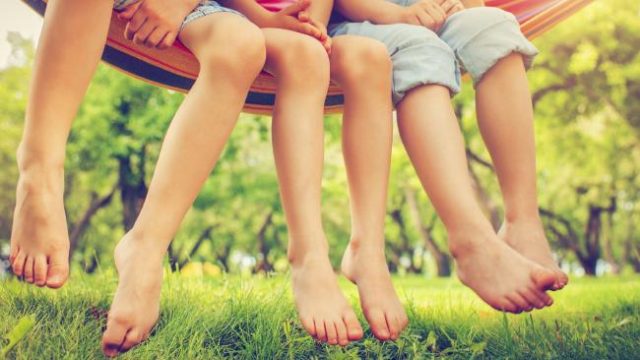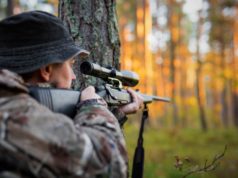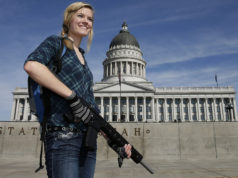Studies conclude that shoes cause foot weakness and deformity in children and are not even beneficial in the corrective sense. Shoes cause loss of foot mobility and significantly alter a child’s natural walking pattern. Do children need shoes for arch support and foot protection? If they do wear shoes, what kind of shoes should they wear?
Shoes limit the mobility of the foot and the whole body. According to Biomechanist Katy Bowman, M.S., “The foot’s 33 joints allow the foot 8.6 X 10^36 unique positions.” She says, “When the feet are stiff and tight (and constantly in shoes) the center of mass (in the pelvis) also becomes stiff and immobile.”
Dr. William A. Rossi, Podiatrist, discusses shoes in an article published in Podiatry Management. He says that shoe wearing children lose normal foot structure and function by the time they are 7-8 years old. Speaking about toes specifically, he states, “In any shoe-wearing society, by age eight or nine, the toes of most children have lost up to 50 percent of their natural prehensile and functional capacity. They are no longer strong, finger-like, ground grasping organs but weak appenditures at the end of the foot.”
Soles of shoes limit foot mobility. Rossi states, “A shoe’s soles, whether leather or other materials, are one fourth to three-eighths of an inch thick. They automatically prevent 80 to 90 percent of the child’s normal flex angle, 55 to 65 degrees at the ball. With shoes on there is very little heel-to-ball movement, thus denying the foot its normal step sequence.”
Shoes cause flat foot and do not provide arch support. A study analyzed 2300 children ages 4-13 and showed that “shoe-wearing in early childhood is detrimental to the development of a normal longitudinal arch.” Researchers found that “The incidence (of flat foot) among children who used footwear was 8.6% compared with 2.8% in those who did not.” Flat foot occurred most in children who wore closed-toed shoes while it was less common in children who wore sandals or slippers and least common in children who went barefoot.
It helps to know what the arch is and how it is formed. Katy Bowman explains, “You should have the shape of an arch in your feet, yes, but if you cut your feet open, it’s not like there’s a fixed anatomical part that is shaped like an arch. The shape of the arch is created by healthy tone the many muscles of the foot, pulling bones here and there until the arch is intact.”
According to Rossi, shoes are not needed for strong arches and feet on hard surfaces. He says, “from infancy on, most of the hundreds of millions of shoeless people of the world habitually stand and walk not on soft, yielding turf (a persistent myth among medical practitioners) but mostly on unyielding ground surfaces.” Furthermore, he mentions people who have exceptionally healthy and strong feet who walked barefoot 20-25 miles to work for 40-50 years on cobble-stoned or paved streets, and others who worked barefoot on hard surfaces while continuously carrying 50-60lbs.
Sneaker soles cause traction. Traction “causes the foot to suddenly “brake” with each step (an average of 20,000 steps a day for an active child). This results in a forward sliding of the foot inside the shoe and a jamming of the toes against the tip of the shoe. This repeated toe trauma is the equivalent of wearing outgrown shoes,” says Dr. Rossi.
Other problems Rossi has with the design of shoes include toes that slant upwards and flexible parts of the shoe not aligning with the flexible part of a child’s foot. Rossi says that “99 percent of juvenile footwear is “ill-fitting,” and that the ill-fitting is worsened when parents buy shoes big to provide “grow room.” He warns to not be fooled by the flexibility of the soles of athletic shoes because where the shoe bends is “in conflict with the foot’s normal flex line angle.”
According to Katy Bowman, another problem with shoe design is that most shoes, even athletic shoes, have heels. Bowman says, children’s shoes amplify the deleterious effects of heels and warns that “your child might be wearing heels right now.” Studies show that heels cause the Achilles’ tendons to be stiffer and harder and the calf muscles to becomes tighter.
So, shoes are bad, but is barefoot good? According to scientists, people evolved to run barefoot, and it “provides increased proprioception (the information the brain receives from the foot that allows the brain to know where the body is in space) and foot strength and is thought to help avoid injury.” Barefoot expert, Jessi Stensland, says the foot even grows its own protective layer of fatty padding that protects from glass and other harmful objects.
In studies, children displayed temporary gait instability while transitioning to barefoot, but studies show that once they are used to the barefoot condition, they ran marginally faster and with more stability than in conventional shoes. While going barefoot and wearing minimalist shoes are the best options, these conditions need to be eased into. Katy Bowman’s book, “Whole Body Barefoot” was written as a guide to help the transition.
Katy Bowman has compiled lists of recommended minimalists shoes for children. She has a list for back to school shopping, summer, winter, and overall wear. Katy’s list includes international shoe companies and companies that do not sell shoes for children beyond infant sizes. Bowman lists Vivobarefoot, which I found to be a fantastic American company that sells larger sizes.
Carozoo moccasins are not on Bowman’s lists, but they are a personal favorite. Their moccasins range in size from newborn to 8 years while other companies do not make sizes beyond 24 months. I love these moccasins because they are very affordable and durable, and they fit great.
Physicians and scientists have discovered that conventional shoes should be avoided, but parents may not trust foot fatty padding alone to protect their child against germs, glass, or the heat or cold. Thankfully, some shoe manufacturers have been working on shoes that better mimic the barefoot condition.








